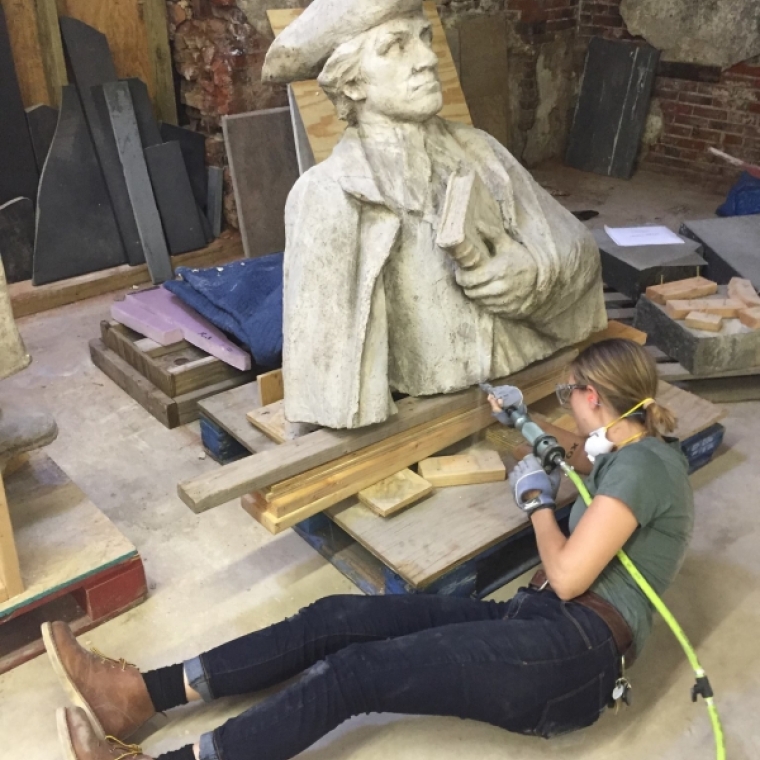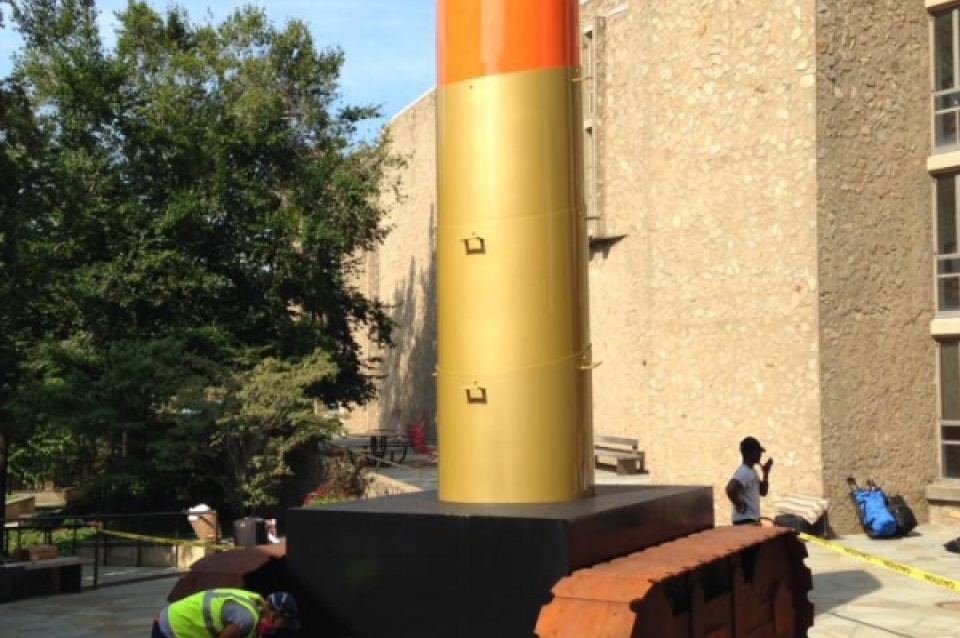

Stuart Weitzman School of Design
102 Meyerson Hall
210 South 34th Street
Philadelphia, PA 19104

Above Photo: Removing mortar from interior of terracotta sculpture by Alexander Stirling Calder
What kind of work are you doing?
I am currently working as an architectural conservator, for Materials Conservation Co., LLC (MC), a small architectural conservation firm that specializes in architectural documentation, conditions assessment, material testing and analysis, conservation treatment of buildings and public sculpture, designing monitoring & maintenance strategies, as well as art handling and installation.
What led you to your current position?
After completing a subcontract for MC, I decided to intern with them for my last semester of my undergraduate schooling. Before that I had no experience in or knowledge of the preservation field. After that, I was hooked. I worked with the company sporadically for a few years and then decided to go for my master’s degree in order to acquire a firm basis of expertise and skill to make me a professional in the field. Shortly before graduation MC offered me a full-time position, and I couldn’t be more grateful.
What attracted you to the firm or position?
First and foremost, what specifically drew me to the position of architectural conservator is how it requires a marriage of expertise in art and science. I love working in the field, I had always wanted to work with my hands, doing something physical. I also thrive having so much variety, each day I come in contact with many different materials, perform all sorts of techniques, and may be in our shop or on-site.
How did your studies at the University of Pennsylvania Stuart Weitzman School of Design prepare you for your work there?
My undergraduate work had given me a great understanding of artist materials, which is invaluable in my career, but I knew little about building materials specifically. The Weitzman School afforded me an opportunity to dive deeper into a concentrated study of the macro- and microscopic aspects of my career.
What I learned about structure and architecture was balanced by a greater understanding of building materials, deterioration, diagnosis and treatment, as demonstrated through coursework performed in the Architectural Conservation Laboratory.
What courses, studios or instructors had the greatest influence on your work or thinking?
Both Frank Matero and Randy Mason were integral in my educational experience at Penn. Frank gave a thorough synopsis of how building materials are used, how they perform and how they fail and deteriorate. His seminar courses were fantastic for focusing on specific materials in-depth. Randy afforded me the knowledge of how to understand preservation philosophically, and how protecting cultural heritage begins with understanding value. I must also mention Michael Henry, because he too fundamentally changed my perspective and approach toward building preservation. Michael instructs his class on how to understand systems, and how to find the links between cause and effect. I feel like the core lessons I learned from each of their courses gave me a well-rounded understanding of the issues I will face working with the built environment and working in the preservation field at large.
I also greatly benefited from Dr. Marie-Claude Boileau’s Petrography of Cultural Materials course through UPenn's School of Arts and Sciences. It allowed me to understand stone and ceramic building materials elementally and microscopically. Lastly the material seminars taught by working professionals Roy Ingraffia, Andrew Fearon, Melissa Meighan, and Cassie Myers were essential in preparation for a career working in hands-on conservation and restoration. I am already relying heavily on what I learned in their classes in my everyday work at MC.
What was the best part of studying at the Weitzman School? In Philly?
The best part of studying at the Weitzman School was learning and being supported by such a diverse faculty, staff, and student population. I feel like the very different experiences of this population allowed for great discussion with a multitude of perspectives. I also was able to make some fantastic friends through the program! Studying in Philly was prime, as the city being the first U.S. capital is steeped in history, and illustrates the efforts of decades of preservation work. Philly is also a serious cultural hub, and is perfectly sophisticated and gritty.
Where do you see yourself in 5 years?
In five years, I see myself being a project manager at MC, and teaching undergraduate or masters level courses in local universities. I would also like to continue performing and publishing research, focused on the performance of building materials and conservation treatments.
Are you keeping in touch with classmates, students or faculty?
Absolutely! I have made some really great friends, whom I see regularly and rely on for advice in the field at times! Living and working so close to Penn has also made it easy to keep in contact with faculty, whom I rely on for advice in the field as well.
Any words of advice for prospective students?
The graduate programs at the Weitzman School are perfect if you are looking for an Ivy League Education with a big-city experience. When it comes to graduate school, dive in, don’t hold back. Get to know all of your classmates and faculty. Explore, and absorb as much as you can. Ask questions, make mistakes, and push yourself harder than you knew was possible. Also become a member of all the professional organizations, and get to know the other members, they are your mentors, and future colleagues!

Casey in-painting areas of paint loss on Claes Oldenburg's Lipstick (Ascending) On Caterpillar Tracks, on Yale's campus